01 UBUNTO THREADS
TUDelft BK Master Architectural Crossover Studio 2023
Individual work
Archive along the Thames River
Site: Deptford, England
Area: 3 ha
Situated on the south bank of the Thames River, Deptford witnessed a significant influx of African immigrants in the 20th century, seeking new beginnings. Presently, the area embodies a complex landscape rich in diverse cultures, yet plagued by issues of violence and conflict. While art galleries on High Street aim to revitalize the community, neighbor participation remains limited due to a lack of shared cultural understanding. The pressing need is to discover a platform that seamlessly integrates both art and neighbors.
Hence, leveraging the renowned African textile production has emerged as the most effective tool to foster connections and bridge cultural gaps in Deptford.
The concept of massing draws inspiration from the intricate actions of weaving. Similar to the interconnection of yarns in two directions to create diverse patterns, the methods of weaving involve a dynamic interplay of wraping, raising, lowering, stretching, hanging, pushing, twisting, repeating, and passing.






2
UBUNTO THREADS COMMUNICATIONS COLLECTIONS WORKSHOPS EXHIBITIONS












5 6 WardBdy Bdy A A A A A A A A A A A A A A A A A A A A A
Chasm" between local commmunity and art institution SITE
area of Deptford A Art Galary of Deptford
the concept of a
village beneath the roof, the massing takes the form of a vertical twisted tower, extending as a cantilever to host the exhibition halls above ground.
Pepys park by intergrating the old wall into new building PASSING STRECHING RAISING REPEATING HANGING LOWERING WRAPING TWISTING Exhibit the "Textile Space" in the archive
the 'new textile' in space."
"Cultural
Residential
Integrating
textile
Connect
"We present

Sky Window window
Glass Balustrade

Within the confines of the Deptford Archiving facility, a compact textile production workshop provides a comprehensive journey through the entire textile-making process – from the creation of the fabric to its final display. Residents in the vicinity are encouraged to bring their own fabrics to the museum, where they can actively engage in crafting their personalized art pieces. The entire creative process is documented and showcased within the museum, becoming a living exhibition that captures the essence of textile artistry from inception to fabric itself.
Textile
Rod
9 10 3 4 Cleaning and Coloring Pool & Decentrliazed Wastewater Treatment System 5 Textile Exhibition Installation 2 Drawing Workshop 1 Remaking Textile Factory 6 Custermized Textile Facade A Drying Shelves Coloring Pool Pressure Fliter Activated Carbon Fliter Control Cabinet Moveble Curtain Weaving Machine Modular Wood Shelves Modular Wood Shelves Dosing Station Osmosis Plant Booster Pumps Cleaning Pool Ceiling Combined Floating Shelves Moveble Door Yarn Shelves
Wall window
Ceiling
Roof Curtain
Tower
Installation
Plarks -160mm*200mm L:5m -Gap 200mm
Horizontal
to Ground -200mm*200mm -Gap 2000mm
-160mm*200mm -Gap 2000mm Circulation
Spacer
Detail A: Ubunto Tower Exploded View



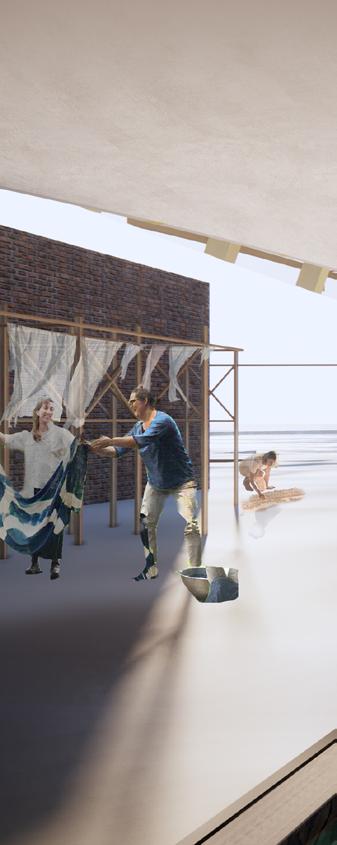


"the machine weaves your textile journey ."


17 18


POSTER BY ZHANG SHUYU DIRECTOR BY ZHANGSHUYU BASED ON AFRICAN TEXTILE
Image1.

02 COLLIDING DISTRICTS

YAC Art Cathedral Competition 2022
Individual work
Musealization of ruins of Kells Priory
Site: Kells Priory, Ireland
Area: 3 ha
Situating at Ireland's rural landscape area, the Kells priory consists of an immense waning meadow surrounded by tall walls with mighty bastions. To the north, overlooking the river, are the vestiges of a church with the unmistakable features of the Irish Gothic. The monastery has been destroyed and rebuilt three times, due to changes in the contemporary religious regime, and it can be said that the building is a tale about religion and war
Reflect on the future of Kells Abbey, beyond its role as a national monument for visitors and tourism. This ruin should become a place where memories of the past can be exchanged and contemporary culture perpetuated. A place that can be transformed into a place of tradition and innovation, a space of contrast between the ancient and the modern. With respect for the past, the new is integrated into the old, changing the future of the cultural heritage
I was inspired by the broken pointed arches and roofless vaults of the ruins, which evoke the long history of the monastery and sublime spaces. Combined with the rational logic, the arch element was repeated and deformed according to the old church order, forming a new building complex to communicate and continue the history experience


Element Broken walls scatter in the ruin record life of past Reserved transept evokes the memory of medieval age Space

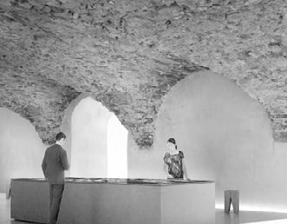
Reclaim ancient cathedaral with comtemporary architecture
The ruins of Kells priory are in fact the product of artists, creative talents and visionaries called to God’s cause to use the best of human technology to celebrate the mystery. The ancient sacred architectures could be reused as places where contemporary cultural innovation can be hosted again, to evoke the historical experience
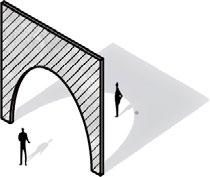


The arch is used for circulation and facade construction
The semi-wall is transparent and used in open space
The cycloid dome produces soft sky light for exhibition






The circulation of the old priory is organized along the traditional Latin cross plan. One side for religious use, another side for daily life
The choir for praying with small arch windows is at the intersection of two orthogonal axis. It is the highest tower and accessible to four directions

C: Open north transept
The last bay of transept remains decorated arch windows and continuous arch corridor that connects outdoor courtyard and indoor church

The arches are used for framing the space
Inspired by the ruins of Kells priory, three forms of arches are selected and combined to generate open, semi-open, and enclosed spaces in a continuous motion
3 4 1193 1300 1352 1239 1893 A A C B
A: Typical Latin cross plan B: Centric crossing tower
Kells priory was founded by Geoffrey Fitzrober
Kells priory was burned by Sir William
The 7 houses were built for fortification
Kells Priory became a National Monument
The priory was secondly destoried by Edward
Old Gothihc Art New Comtemporary Art COMMUNICATION
Wall Wall Semi-wall
Semi-wall Dome Dome 1 1 2 3 2 3


5 6 Site plan 1:1500 Consistent New Courtyard Old ruins New construction a a a a a a a a a c1 c2 c3 c4 A A b1 b1 b b b b b B B b2 b2 b3 b3 c d c+d 0.5 c 0.5 c Gradient Assemble New corridor Proportional New Roof New Portico
The new circulation follows the order of old cross plan


1 Outdoor
2 Arch corridor
3 Ruin
4 Exhibition entrance
5 Pool
6 Exhibition
7 Old nave
8 Old chapel
9 Watchtower
10 Exhibition exit
11 Cafe
12 Manager room
8
Plan 1:400
Ground Floor
ruin
1 2 2 3 3 4 5 6 6 7 11 10 8 B 9 12 Old portal New watchtower Exhibition Workshop Lounge Old courtyard Ruins Office Old chapel Kings River
arch corridor Exhibition hall Old corridor Manager room Cafe Bridge Watchtower New courtyard Fragments of ruin Exhibition hall Exhibition corridor
New
B A A





Solid comtemporary exhibition space within the old ruins Outdoor
Section A-A (east-west axis)
The axisis contains comtmporary exhibition space which accommedate "top and bottom" exhibition unit respectively. The two naves are connected by crossing tower, enda at the newly built cafe and offce building

Section B-B (north-south axis)
Transparent corridor connects the old and new
The corridor aligns with the old church vertial axis. Three sizes of arched range from large to small are organized in the open, semi-open, closed space respectively
9 10
arch
Arch corridor under vault
hall Watchtower
Exhibition hall
corridor Cafe and Office
Exhibition
Old chapel under glass roof



11 12
The arches are arranged rhythmically on the continous wall
"Up-down" exhibition hall with new and old
The old courtyard is enclosed by new walls and arched corridors
To maximize the value of ruins, the new contemporary exhibition box is floating on the old church fragments: The ground floor is totally opened and used as an outdoor exhibition area protected by arched partitions; the upper floor is divided by arch modular walls and used as a contemporary museum

1 Roof
2 layers of bitumen roofing felt
24mm groove boards
100mm ventilation cavity
100*100 rafters
20mm bitumen-impregnated softboard
220mm cellulose insulation
120*220 mm pulins
24mm open boarding
2*10mm plaserboard810
2 Exterior wall
25mm painted mineral render
365mm perforated clay masonry
15mm gypsum board
lime-coat render
3 Floor
Marble floor covering
10mm hot-rolled asphalt
45mm cement screed
20mm impact sound insulation
200mm reinforced concrete floor slab
4 Window Metal window with double glazing


13
The use of lightweight clay masonry guarantees the structure safety of old ruins
4 1 2 5 3 3 2
5 Reserved structure

03 SHIFTING PUBLIC EDGE

Individual work 2022
Theater center design
Site: Paris,France
Area: 3400m
"A movie theater needs only a projection booth, an auditorium and a screen; but behind Radio Clty's screen stili exists another realm"
--Radio City Music Hall, Delirious New York,Rem Koolhaas
La Défense and Arc de Triomphe is located on the main axis of the city as a new development area of Paris. The area is crowded with high-rise buildings and countless office buildings. A theater center is needed without delay
As a public building, the flow and function of a traditional theater is not so open. People enter the performance hall from the front hall, the flow is relatively single, and there is no opportunity to communicate with others
The project accommodates a wide variety of performing arts spaces, from a hall suitable for symphonic music to a fully open festival venue that caters to all types of musical events. Meanwhile the public spaces surrounding the theater from top to bottom vertically offer citizens a stage for daily life



2
The void space is changing according to the adding and subtracting of solid cube









The organization of public area is based on the scale of each theater
17 18
Theater: a social condensor for citizen
Main concept: Theater could be accessible for everyone
Theater combined with daily life Vertically organized theater circulation
5 Gallery-Terrace
4 Theater-Theater
3 Square-Sqaure
2 Rehersal-Theater
1 Entrance-Gallery
Singular circulation within traditional theater space
The shifting public edges along the main circulation
In a traditional theater black box, the three main parts of the theater: font house, chamber, backstage, exist independently without any interaction
Chamber
Fronthouse Stage Stage Backstage Audience
5 4 3 2 1
BELOW HOUSE CHAMBER ABOVE HOUSE

Redefine the circulation of theater combined with public space Above
Three theaters are independently and interconnected simultaneously: the house below is responsible for the actors, the chamber is for watching and performing, and the above house consists of public space which are linked together in the whole building

19 20 1
Main entrance
Reception
Cafe
Reading stair
City hall
Gallery
Meeting room
Office room
Fire stairwell
Toilet 11 Staff Entrance 2 3 4 5 7 8 9 10 11 6 Ground Floor Plan 1:300 Office Gallery Cafe Square Square Terrace Gallery
1
2
3
4
5
6
7
8
9
10
House Public space Interconnected Chamber Performing soace Closed
House Backstage Articulated Site Plan 1:2000
Below

Theater variation
Put various sizes and form theaters into cubes at different levels
Void creation
Make the void as a big city stage that consists of theater and daily life
Visitor circulation
Create the loop for public visit, enabling the publicity of the building

Flow diversion
Arrange the main entrance in the west facade, and stuff entrance in the north facade
Daily life insertion
Integrate daily life activities which encircling the theater black boxes vertically
Outdoor connection
Connect the building with the surrounding to make views of Seine River

The atrium is the stage for the city and citizen

21



23
Juxtaposition of two theaters: The atrium connects Grand theater and nightclub
Standard Floor Plan 1:300
Proscenium-arch Stage in spherical playhouse












25 26
Entrance hall space
Rehersal room& Open area
Sky terrace & Roof garden
Lower part
Section Diagram Plan
Middle part
Upper part
Theater as actor of daily life
Theater and daily life are connected by void space
Daily Life VS Theater
Theater as daily life

Average Day at the theater

04 SENSORY INTERFACE
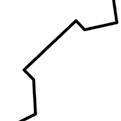
Politecnico di Torino 2022 Spring Design studio
-Architectural and urban design in Aurora,Turin Individual work
Instructor: Carlo Deregibus carlo.deregibus@polito.it
Site:Turin,Italy Area: 8.5ha
The aurora area is about one the most intriguing areas in Torino, the Royal Gardens. There, an historical wall divides two sides of the city:a physical,social,economic and perceptive separation enhanced by the architectural and functional between the upper and lower gardens
The project renovated the abandoned public park under the royal garden through defining functional and nonfunctional requirements for various types of users whose preferences rarely were consistent with each other, and to define the cultural values of the area. The historical architectural elements are extracted and transcripted into present language, to create an imaginary past and collective memory of locals
Between the real present and real history, People are placed in a fictional past, a historical memory processed through architectural elements.By understanding the difference between the imaginary past and the real past, people can locate where the world is today

make a space full of traces of the past in a completely new way
To
Abandonded park at historical city center
The Aurora area is located at the historical center of Turin, closed by ruins of ancient fortification and one main road of the city. The origin of the fortification wall dates back to the Roman empire period, undergoing three times of enlargement and several times of redesign for defending. The overlapping fortifications provide evidence of technology of the military in different periods. Then in the 19th century, affected by "European phenomenon" that means the island-like urbanism reached the end, the wall was gradually demolished


1st century B.C. Middle Ages
The Romans founded Augusta Taurinorum about 25 B.C. The city was enclosed within a powerful defensive square, and four gates were built on the four sides and connected two streets. The forum was located at the intersection of two axes
The French dominated the city in the 16th century and planned Turin as the capital city of the Savoy dynasty. In order to adapt the appearance of gunpowder, the triangular shaped fortress and thicker walls were designed for stronger fortification. A pentagonal citadel was planned at the west-north corner of the city
Early Modern Ages 19th Century to our age
In this period the city has undergone three-times enlargement. Piazza Reale, Palazzo Reale, and Via Nuova were added along with the first enlargement of the walls.And the building arcaded Via Po, connecting Piazza Castello with the bridge on the Po through the regular street grid in the second enlargement
The fortification was demolished, only some segments were preserved near the Royal Palace. The old city area changed from a princely privilege to a space of public service and pleasure. Turin was once planned for the capital city of Italy, further districts were developed for salubrity and convenience
Wall segregation:
Abandonded park&Royal garden
Nowadays, the preserved wall has become a tourist point for visitors and the boundary of the royal palace and royal garden. In this sense, the six meter height wall separates the area into two parts: The upper garden which was designed by André Le Nôtre. He proposed two axes in two directions in the garden. The lower garden came out after the corso Regina margherita was built as the outring of Turin. The prototype of the lower garden was given by the moat, and it was used to be the expansion of the royal garden, the royal zoo. However, it was almost abandoned until in 1867 reprogrammed in a centrosymmetric style


2nd Enlargement
3rd Enlargement
The wall witness the history of Turin
31 32
SITE
Roman wall
Monument Community
Settlement
Reminiscence
Typology
Reinterpretation

The heritage is activated by transcripted them within new spaces
Four types of elements range from urban scale to architectural scale are extracted from the context of the wall, and transcripted into different forms to reproduce the history with social requirement




Public park Market University Factory
Walk the dog in the morning
Procurement of living materials Activities in campus Work from day to night

Royal

museum Royal garden Shopping center


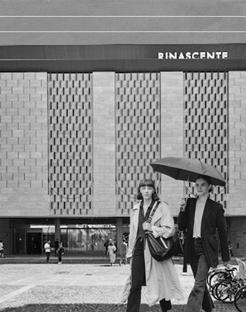
Two kinds of target people along the wall:Tourist and local
The wall divides two sides of the city: a physical,social,economic and perceptive separation enhanced by the architectural and functional difference
33 34
The Order
Forum wtih old and new
Tower as mirrored history Tower as vertical connection Tower in plan organization
Order for facade expression Order for enclosed space Order as viewfounder
Forum with various floors Forum in human scale
Axis as intersection Axis as visual corridor Axis as building
The axis
The Forum
The Tower
Enjoy
with
palace Sabauda
Visit the historical building Experience the moment of past
the sunlight Hang out
friends


The spaces on three nodes imply the historical spatial logic combining reality
The method is to help to create a completely new approach to designing with ancient ruins, but also to create new way of forming spatiality
35 36
Node Formation
Overlapping memories coexist on the site
Site as public park(1914-2022)
Site as royal zoo(1861-1886)
Site as moat(17th century)

Define corridors
a:respecting of history
Three Axis connect history and present. They start from the historical monument, and end at the present functional building
b:continued urban texture
The grid continues the urban texture of two sides to break the separation
Divide symbolic area
The site is divided into three parts following the developing sequence of upper garden
Generate new identity
Three new cores were sited such that they would not obstruct views from within the historical building

37 38
Ground Floor Plan 1:3000
New spatial organization surrounding the monument



 Node 1: Enclosed space at the end of wall
Node 2: See and be seen
Node 3: Watch tower
The linear stair and amphitheater connect the upper Royal Garden, Bastion verde, and Theater Rai
Three historical axes converge at the node. The triangular pavilion provides a view with an arched frame to the old wall far away
The tower provides the highest view point of the surrounding area. The horizontal building accommodates neighborhood life
Node 1: Enclosed space at the end of wall
Node 2: See and be seen
Node 3: Watch tower
The linear stair and amphitheater connect the upper Royal Garden, Bastion verde, and Theater Rai
Three historical axes converge at the node. The triangular pavilion provides a view with an arched frame to the old wall far away
The tower provides the highest view point of the surrounding area. The horizontal building accommodates neighborhood life




41 42

05 IN-BETWEEN REALM

Politecnico di Torino 2021 Fall Design studio
-Building Construction Studio
Corperated with Xing tongxin, Lin juan, Wu kexin Role in team: reasoning, modeling,design and drawing
Instructor: Walter Nicolino
walter.nicolino@polito.it
Site: Tokyo, Japan Area: 320m
The bubble economy in Japan triggered a rise in housing prices and the spread of single culture, and the new generation in Japan gradually moved from the one-family buildings that were everywhere to compact apartments in the city. But the small apartment does not allow two generations to live together, and the relationship between parents and children becomes distant
The site is located on the outskirts of Tokyo, the edge of the city center and the countryside, implying a constant turnover of housing.There is a need for closer communication between the new generation and the older generation, I tried to address the issue focusing on the combined ways of each units
The three-floor mix-used building provides four units for two families, connecting with the big terrace in different heights above the ground. The particular layout balances the demand of both privacy and publicity. And on the ground floor, the office and public space offer a "free-space" in the society. All neighbors could share the cafe behind the office, chatting with friends
2









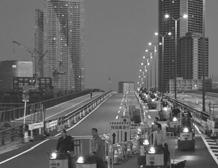












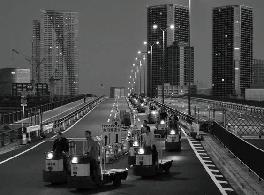




Social changes have led to changes in Japan's housing structure
In the past fifty years, large changes have happened among Japanese families. The land price in Japan increased rapidly because of the economic bubble;Elderly people passing away and young people moving to cities increased vacancy rates. The housing market is gradually leaning towards apartments instead of single family houses
Apartment buildings with shared space combine the best of both housing types

During the 20th century, most Japanese lived in one single house with their family members. They owned a large shared outdoor courtyard in the form of closed or semi closed. And roominess which provided more area for double height, attic,storage space
Compared to the single family house, apartment blocks accommodate more inhabitants per unit and decrease the construction cost. The simple layout also satisfies all kinds of users like students, couples, singles. They can choose personalized housing according to their requirement
People tend to move from one-family buildings to apartment buildings

45
High quality public space
A: Single family house
Flexible staking units
unit a unit a unit a unit a unit a close stagger lock rotate parallel unit a unit a unit b unit a unit b
B: Multiple-unit building


MAXIMUM VOLUME
The resulting volume meets the requirement of setback (2m north and 3m from east)

UPPER APARTMENT
Two apartmetns are arranged in th rest of space

GROUND FLOOR OFFICE

SHARED TERRACE
The terrace connects two single apartments for the young and the old in a family
An architecture studio and retail are arranged on the ground floor 1

STREET-FACING FACADE
The outdoor stairs are tapered to continue the notion of connection

OPENNING & SHADING SYSTEM
The renovated "Engawa" are created according to the function
47 48
Cafe
Office Entrance
Reception
Office area
Toilet
Manager room
Engawa
Apartment entrance Ground Floor Plan 1:300
2
3
4
6
7
8
9
Unit 1a
Floor: 1th -2th
Area: 60m2
User: Mika 26yrs
Description:
The living room equips with flexible furniture and the small movie room provides a relatively private space for user
Unit 1a
Floor: 1th
Area: 80m2
User: Kato 71yrs
Description:

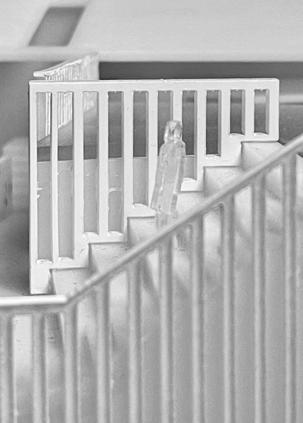




Good lighting and ventilation with semitransparent glass for activities of elderly people from day to night The
49 50
and
hierarchy provides life
diversification Public Private Transition of spaces is realized by shared balcony Open sky terrace Transitional shared balcony Private living room Mika Niki Kato Yuri
public
private
with
Mikuto
and Juro
Unit 2a
Floor: 3th
Area: 55m2
User: Yuri 60years
Description:
Linear plan with mezznine which accomodates
Chashitsu (Japanese tea room) for friends
Unit 2b
Floor: 2th-3th
Area: 124m2
User: Mikuto and Juro Young couple
Description:
The lower floor is planned for working and public use. The study room is divided into two parts for two people which is independent. The upper floor is used as bedroom and leads to terrace



51 52
Flexible unit layout promotes communication between two generation Interpenetration of living space and public space
Window:
Aluminum sash
Wired glass 6.8mm
Clear glass 5mm
Perforated Aluminum louver

Sliding door:
Aluminum sash
Vertical standing seam
Polycarbonate panel 3mm
Floor:
Janpanese oak flooring 15mm
Underfloor heating 12mm
Structural plywood 12mm
Rigid insulation foam 30mm
Structural plywood 12mm
Roof:
Wood beam 120*150mm
Rigid insulation foam 30mm
Structural plywood 12mm
Rigid insulation foam 30mm
Cement excelsior board 12mm
Adjusting bolt stainless steel M12 @910mm
Alaska cedar 27mm @110mm
Exterior Wall:
White metal panel 3mm
Aluminum supporting profile
Vertical ventilation furring strips
Vapor-permeable membrance
Structural plywood 12mm
Glass wool insulation 120mm
Structural plywood 12mm
Cement borad 15mm






















































































































 Node 1: Enclosed space at the end of wall
Node 2: See and be seen
Node 3: Watch tower
The linear stair and amphitheater connect the upper Royal Garden, Bastion verde, and Theater Rai
Three historical axes converge at the node. The triangular pavilion provides a view with an arched frame to the old wall far away
The tower provides the highest view point of the surrounding area. The horizontal building accommodates neighborhood life
Node 1: Enclosed space at the end of wall
Node 2: See and be seen
Node 3: Watch tower
The linear stair and amphitheater connect the upper Royal Garden, Bastion verde, and Theater Rai
Three historical axes converge at the node. The triangular pavilion provides a view with an arched frame to the old wall far away
The tower provides the highest view point of the surrounding area. The horizontal building accommodates neighborhood life



































